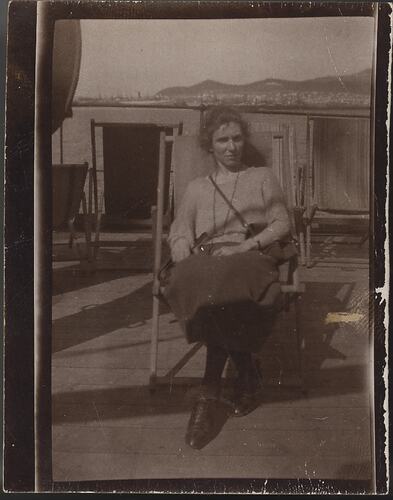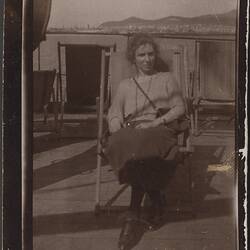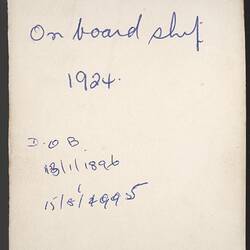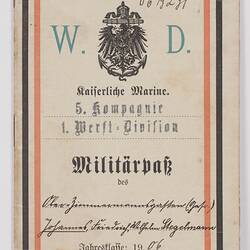Summary
Black and white photograph of Gladys Leichti, seated on a deckchair on board the SS Bendigo in 1924. The image was taken during her voyage as an assisted immigrant from England to Australia.
Gladys Muriel Leichti was born in London on 13 January 1896. One of six children, her father was a tinsmith, so money was tight, and Gladys worked mainly in domestic service, as well as in a munitions factory during World War I. On 24 January 1924, at the age of 28, Gladys was one of 180 passengers (including 42 girls identified for domestic work) brought out to Australia by the Salvation Army on the T.S.S. Bendigo. On arrival in Melbourne Gladys went straight into service in Warrnambool on the southern Victorian coast, but returned to Melbourne after a few months. She found a live-in position as a cook with a family with two children in Melbourne and stayed there for four-five years, from about 1925 to 1930.
In 1935 Gladys married German immigrant Johannes Stegelman. German born Johannes (Jack) Stegelman completed a shipwright's apprenticeship in 1904 and became a carpenter on merchant vessels. Between 1907 and 1909 he spent time in the German Navy but then went back to working as a carpenter on merchant vessels. In 1911 he worked with the German Australian Steamship Company and when he was docked in Australia he, along with two others, jumped ship as he wanted to avoid being conscripted into the German navy again.
The couple lived in St Kilda and Prahran and had three children Margaret, Helen and Bruce.
Description of Content
Gladys Leichti seated on a deckchair on board the 'SS Bendigo'. There is a port in the background. She wears a jumper and long skirt.
Physical Description
Black and white photograph with black border.
Significance
Gladys Leichti's objects and story represents the push to attract young British girls for domestic service in the 1920s and the role of philanthropic organizations such as the Salvation Army in meeting this demand. The story is also interesting for its cross-cultural marriage and the bringing together of two very different migrant stories from different periods in time.
Johannes Stegelman's story is a great example of more unorthodox migration. Jumping ship was a common way to start a new life in Australia, especially for sailors on merchant ships, and dates back to the 1850s gold rush with sailors jumping ship to head for the goldfields (John Simpson Kirkpatrick of 'Simpson and his donkey' fame arrived in Australia by jumping ship). Stegelman's objects all relate to his career in both the German Navy and the merchant navy including the hire document that brought him to Australia.
More Information
-
Collecting Areas
Migration & Cultural Diversity, Public Life & Institutions, Transport
-
Acquisition Information
Donation from Margaret Steglman, 29 Nov 2006
-
Person Depicted
-
Place & Date Depicted
-
Format
Photograph, 3 in. x 4½ in., Black & White
-
Inscriptions
Text, reverse: on board ship/1924/D.O.B./13/1/1896/15/8/1995.
-
Classification
-
Category
-
Discipline
-
Type of item
-
Image Dimensions - Photograph
8.9 cm (Length), 6.9 cm (Width)
-
Keywords
Assisted Immigration, English Immigration, Immigrant Shipping, Immigrant Voyages, Immigration Policies, Religions: Salvation Army, Ship Memorabilia, Domestic Work, Women's Work



